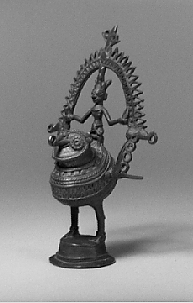 Up to Nalin Home Page
Up to Nalin Home Page

Laksmi
Brass/Metal
Height: 18.8 cm
Twentieth century
Catalogue number 14.
Accession number 86.327.
This "folk" image of the goddess Lakshmi, made by the wax-wire process, shows her riding on a giant owl. Behind, a spiky aureole surrounds her. Unlike "classical" Hindu images of this goddess, such an image may have been commissioned by rural housewives from itinerant artisans. These women usually provide the metal scraps as this lowers the cost of the image.
According to the Matsya Purana, Lakshmi arose from the primordial ocean when it was churned for ambrosia, and she was claimed by Vishnu as his consort. Although she is associated with Vishnu, in Bengal, she is venerated in her own right, as the goddess of the harvest and prosperity. Her most important festival occurs on the night of the harvest moon, when she is invoked to bless the newly harvested rice crop. She is worshiped in temporary street pavilions, in temples as well as in home shrines at this time. Temporary shrines are set up in the home with an image, a pot of rice, and rice-paste patterns of her footprints on the floor.
Lakshmi is also the goddess who presides over the home and women. They pray to her for peace and prosperity, thrift and order. The good housewife is called lakshmi, the benevolent goddess of the home, and a well mannered, disciplined daughter is also called lakshmi. Although she may be worshiped every day, special prayers are dedicated to her, particularly on thursdays.
In contrast to a "classical" image, such as that of Uma and Maheshvara (no. 13), this image represents a traditional art known as dokra, which is practiced by specialized communities of craftsmen such as the Malhar. It is cast by a particular variety of the "lost wax" process by which threads of resin wrapped around a clay core are melted out by the entry of liquified metal, either brass or cheaper scrap metal.
 Back to Previous Image
Back to Previous Image
 Forward to Next Image
Forward to Next Image